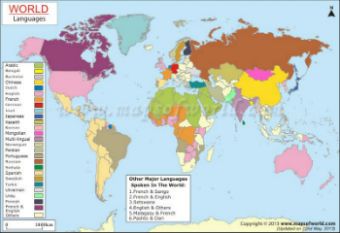As of today, Maps of World will be introducing a new series: Languages of the World. Having done a lot of projects on the geographical wonders of our planet, we felt it was time to have an in-depth look at some of the most amazing aspects of the humans who populate it. And language, as any linguist or neurologist can tell you, is one of the most complicated and fascinating achievements of the human race. Languages are truly alive, growing and changing just as the people who speak them do. Much like people, languages all come from a common root and have since spread into countless forms.
Specific data on how many people speak a language is actually more elusive to obtain than it might seem. Although on its surface it is a simple question, it invites other, more complicated questions about the very nature of language itself. For instance, just what is a language? Are a dialect and a language fundamentally different from one another? How are the different languages related? These are questions that only scratch the surface of the magnitude of the task that linguists face in acquiring a definitive number of how many speakers around the world use a particular language. Other problems include no clear idea of how well a person must know a language to count as a “speaker,” and whether groups of dialects should be tallied together or separately, etc. In reality, none of these questions will ever have scientifically objective answers.
Language is one of the few things that can be said to be purely human, as no form of animal communication has been proven to match human language in complexity (although there is still much to discover about the subject). Additionally, any given group of humans will always develop a language, no matter what their cultural background. New forms of language will crop up spontaneously even in communities that are somehow shut off from other types of communication (such as the deaf community’s sign language, which is every bit as sophisticated as verbal language). The development of language is even believed by some to have been partially responsible for the evolution of sentience in human beings.
Though infinitely complex, all languages have certain things in common. They are a system of combining a limited array of symbols, such as sounds or an alphabet, to express an unlimited number of concepts. The rules of this system will be constituted into a method of grammar, something that all true languages possess in some form. Humans acquire language through socialisation rather than through genetic memory, the latter being the case with many forms of animal communication However, the astounding capability of the brain of a human infant to learn new languages is something that all of us are born with.
Tongues of the World will be an exploration, one by one, of some of the most important languages, dialects, and language groups in the world. We will look at the basic structure of each language, its roots, its quirks, and the way in which it interacts with the culture that created it (and how it affects other cultures around the world, for that matter). Please join us in celebrating the miracle of human communication. We’re looking forward to all of your insights!
Language is no longer a barrier. All of us can cite numerous examples of how we have managed to get by without knowing the native language of the city, or at the very least we have all lived to tell the tale. Knowing the language of the land just makes our job a lot easier. It is certainly not necessary to be a linguist or a grammarian: basic spoken-language skills combined with exceptional vocational skills is a surefire recipe for growth and acclaim the world over.
The intermingling of speakers of inherently distinct native languages, thanks to pathbreaking communication advancements over the last couple of centuries, has diluted the concept and importance of mother tongue/ native language. Native language may no longer reflect the person’s ethnic group.
This trend has led to hundreds of languages dying around the world, and hundreds more are marginalized and headed towards extinction. Some languages have seen a very high degree of vocabulary imported from other languages, leading to their reclassification as a dialect of a major language and thus losing their “independent language” status. It is widely believed that business, religious and political factors have been foremost in bringing about this change.
A rough estimate suggests that over 80% of the world’s population knows at least one of the following major languages as their first or second language:
- Chinese – Mandarin
- Spanish
- English
- Hindi
- Arabic
- Bangla
- Portuguese
- Russian
- Japanese
- Punjabi
- German
- French
The six official/business languages used in the United Nations for transactional and inter-ministerial meetings are:
- Arabic
- Chinese
- English
- French
- Russian
- Spanish

